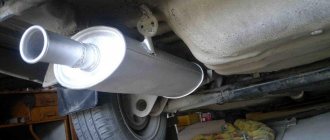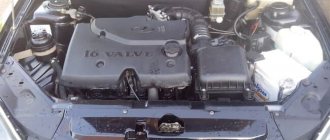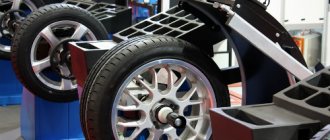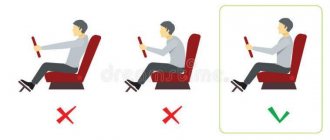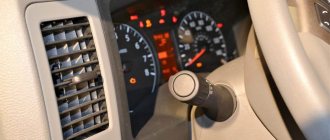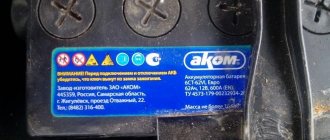Gluttonous 1.8 engine
The original 122-horsepower 1.8 unit, which had been reaching production cars for a long time, was disappointing in 3 ways: it turned out to be not very vigorous, and also greedy for fuel mixture and oil.
Car owners will have to come to terms with gasoline consumption in toffees exceeding 10 liters. But after upgrading the engine, we managed to get rid of two other problems.
To improve traction characteristics, engineers dug into the firmware. And to eliminate the oil burn, large-scale modifications to the hardware and assembly procedures were carried out.
Newsies have begun to complain less frequently, but individual episodes of increased oil consumption still occur.
Read - what kind of oil to pour into the Lada Vesta engine.
About spare parts
- Prices from official dealers are not the same, but may differ several times. For example, a set of front brake pads can cost from 1,500 to 3,800 rubles at different dealers.
- The most expensive spare part was the muffler - 11,000 rubles.
- Almost all spare parts for Vesta have to be purchased to order and wait on average 1 month.
Show/Hide text
| Costs for a Lada Vesta car | ||
| Mileage, km | What was spent on | Amount, rub. |
| 3500 | Wheel cap | 100 |
| 6375 | Brake pads | 2420 |
| 7930 | Exhaust system mounting support | 50 |
| 10020 | Exhaust system mounting support | 50 |
| 10020 | Brake pads | 1950 |
| 10100 | Wheel cap | 100 |
| 11790 | TO-1 (oil, oil filter) | 2800 |
| 12580 | Engine plastic cover retainer | 110 |
| 15850 | Brake pads | 1950 |
| 16260 | Wheel cap | 100 |
| 18320 | Exhaust pipe | 11300 |
| 20300 | Exhaust system mounting support | 50 |
| 23250 | Muffler suspension | 200 |
| 23750 | TO-2 (oil, oil, air, cabin filters, spark plugs) | 5500 |
| 25520 | Rear shock absorber | 3100 |
| 25600 | Antenna | 4500 |
| 26000 | Rear shock absorber | 3100 |
| 26800 | Rear suspension beam silent blocks | 1220 |
| 27600 | Brake pads | 1950 |
| 30300 | Wheel cap | 100 |
| 31200 | Wheel cap | 100 |
| 31500 | Heater radiator (complete with heater) | 19000 |
| 31800 | Release bearing | 4450 |
| 31800 | Secondary shaft bearing | 1450 |
| Topping up engine oil (for the entire period) | 320 | |
| Total for maintenance and repairs | 67920 | |
| other expenses | Tires (4 sets) | 44000 |
| Gasoline AI-95 (average consumption 12.3 l/100 km) | 145630 | |
| Total expenses | 257550 | |
Knocks in the suspension
In general, West levers last quite a long time. Extraneous noise may come from shock absorbers and stabilizer struts. The latter, by the way, sometimes did not live to reach 10 thousand km. Over time, the plant produced improved parts.
It is worth noting that car dealers agree to replace shock absorbers only in the case of clearly visible oil leaks. If the noise-producing elements are dry, the owner may be refused repairs.
And on little things...
Some of the disadvantages of the Lada Vesta listed below can be attributed to nit-picking and not to serious shortcomings, but they still exist and create inconvenience for car owners:
- narrow pedal assembly;
- insufficient rear visibility;
- frequent malfunctions of the heated windshield;
- excessive sensitivity of ABS fails;
- no lock on the gas tank cap
- Incomprehensible operation of the central locking.
In general, eliminating factory defects for AvtoVAZ is one of the priority tasks in the policy of improving product quality. It is important for consumers to contact their personal managers in a timely manner not only with serious problems, but also with minor defects, thus making their contribution to the elimination of factory defects by the plant.
Rusting exhaust system corrugation
The short-lived exhaust tract has always been the weak point of the Lad, and Vesta is no exception. Corrugation rusts very quickly. For some time this does not appear in any way. However, after about 40 thousand km, the timbre begins to change, and in the end the “swallow” with the roar of a fighter has to go for repairs.
Previously, the production warranty was only 1 year or 35 thousand km. But now the domestic manufacturer is ready to replace the failed device within 3 years of operation (100 thousand km).
Transmission noise
A noise is heard from the gearbox, a small knock that disappears when you press the clutch pedal.
There are 2 misconceptions:
- The release bearing hummed. But it shows itself only at the moment the pedal is pressed, when the load on the clutch bearings begins.
- The input shaft bearing is humming. This is also incorrect, since SKF bearings have been installed on VAZ boxes for many years. There is practically no marriage on them.
In fact, the culprit of the knock is the clutch driven disc, namely its central bushing.
It has play in the seat. During torsional vibrations at idle, a fractional knock appears. The problem is solved by installing new clutch discs.
Turn signals not working
Turn doublers made of LED elements, built into the exterior mirror housings, turned out to be short-lived. At first, they were deprived of tightness and died from water getting inside, and later without the participation of moisture.
There are no problems with warranty repairs.
Now this problem is much easier to treat than it was at the start of sales. If previously it was necessary to change the entire mirror in a long and tedious manner, now only the optical elements are changed. If the warranty period has already passed, replacing the LEDs will cost 500 rubles.
Lada Vesta is a VAZ, not a foreign car - Vesta jambs that everyone should know about!
Today there is an opinion that Lada Vesta is not an AvtoVAZ, but a foreign car, but this is not so. Now we will figure out why.
If you have ever owned a car manufactured by AvtoVAZ, then you understand that it has a number of features that are already history in the modern world.
Usually AvtVAZ or TAZ cars are carts that are designed to take you from point a to point b. Yes, of course, we must admit that the Lada Vesta is a giant leap towards foreign cars. Even in safety tests, it showed good results. But if you think that everything about it is perfect and this is really a car at the level of a foreign car, then you are very mistaken. Of course, it has a lot of new electronic toys, which not all used foreign cars have. But some of all this paraphernalia is needed only at face value, and you simply won’t buy much of it yourself, because not everyone will dare to take Vesta at maximum speed.
Let's look into the flaws and shortcomings of the Lada Vesta: If you open the hood, then under it you will find a classic VAZ engine, which has a fairly floating idle speed, as well as a fair amount of oil leaking from various cracks. For example, oil likes to seep out from under the head. Yes, this problem is not as common as, for example, on older Opel engines, but in general you can still encounter such a problem. Also, this motor is not distinguished by its high torque or any outstanding properties; it is an ordinary motor that will be quite reliable, but also voracious. Also, when you open the hood, you will find that we all use the familiar old oak tubes and clamps that need to be constantly tightened. Alas, self-tightening clamps were not delivered again. If you look at the hood lock, you will immediately recognize it as being made by VAZ. Prepare some electrical tape and then perhaps it won’t rattle. There is also an interesting problem related to the doors: when the snow begins to melt, the water from the snow flows through the doorway and ends up on the thresholds of the car, where it safely freezes and turns into an ice skating rink. Many Vestas have plastic door stops that do not work. If you open the door in windy weather, it may fly away and not be fixed, which can lead to damage to nearby cars. Many owners note that the brushes are useless, they begin to peel over time and the paint peels off, so they often have to be replaced with better ones. Absolutely all Vest owners recommend immediately purchasing additional mesh for the bumper, since the slots that are installed at the factory allow whole fingers to squeeze through, and therefore stones can easily fly into the radiator. There are also problems with the frill, in which the drain holes under the hood sometimes become clogged and water begins to stagnate, which means water begins to leak into your cabin. Therefore, you need to keep it clean and try to remove debris from under the hood. If you live in the outback, then it will be very difficult for you to control the car data after any accident. The thing is that these X's on the doors are a pain for any tinsmith or painter, and putting putty on them will also be just a horror. Today, painted doors from the Vesta plant cost 21,000 rubles. Moreover, the quality of the purchased doors may be lower than those installed from the factory and they will begin to rust. Well, what did you want? It’s Russia. Ordering body panels will generally be a problem, since they are not sold separately due to the newness of the car, or so AvtoVAZ wants and you can only order a solid panel, which you can then cut and use the necessary elements. You will have to find a buyer for the remaining body panels. Personal experience of a familiar tinsmith. If you haven’t seen foggy headlights for a long time, then this is a common problem on the Lada Vesta, as on all VAZ cars. AvtoVAZ has never been famous for the quality of its rubber, and therefore many owners additionally glue rubber products. Over time, the rubber bands become more oaky and, accordingly, crickets and various problems associated with this appear. The quality of the plastic remains at the same level as in the Priora; if you have sat in a VAZ car, you will immediately recognize it. The door cards look, of course, interesting, but the quality of the plastic to the touch is the same old VAZ quality. On Vesta, as on most VAZ cars, the door windows are scratched due to frequent raising and lowering, which many Lada Vesta owners write tearfully about on the forums. What are the advantages of Vesta? Of course, Vesta has its advantages, there is less noise, there are also fewer squeaks, but they have not gone away. Also, I would like to note the presence of a good standard sound system.
The noise has become better, the EUR is still the same incomprehensible, but it is tuned and works better than on Kalina, I guess because it’s finally a subframe.
Summary: On the move Vesta is comparable to Logan, many people say that Vesta is B0? But AvtoVAZ Renault and Nissan hide such information and even I can agree that, whatever you want, I don’t like the B0, what? Well, if you don’t like it and don’t care, let it be LadaStyle))
If we compare Vesta with Granta, then Vesta is certainly better. Vesta is still something comparable in base and dimensions to foreign cars. Granta is something “before” and there’s nothing you can do about it. It drives like the TAZs drove 10 years ago, Vesta is already different, completely different.
But still, if you want a foreign car with an automatic transmission, then no, Vesta is not for you! The owner of Vesta must be with his hands!
Still, this is AvtoVAZ and people take it with the thought that it’s ours, it’s cheaper to maintain and easier, more versatile to operate. Yes, this suits Grant, but not Vesta.
Yes, it’s a good car, but it’s expensive and for the money it’s still worth getting a foreign car. But if you want to save money, take a used one, if your religion is only new, well then Granta doesn’t need to expect something magnificent from Vesta, a VAZ is a TAZ. We like to ride!
By the way, for fans of Logan, I want to say that this is also not a foreign car, rather a transitional stage, but comparing Logan with Vesta, we can say that Logan has higher quality, but here the factor of design and religious preferences is already included.
Copying information from the site greednews.su is permitted only when using an active hyperlink to the news, thank you for appreciating our copyrights!
Share link:
More interesting articles:
Vesta burned down, who is to blame?
I compared the VAZ with the Daewoo Nexia: in the end, which is better?
If you get into a skid on a slippery road, how do you get your car out of the skid?
Lada Granta FL fuel consumption measurements, what is everyone silent about?
- Auto News
The page has been viewed - once!
Rate this article:
(
1 ratings, average: 5.00 out of 5)
But you are probably more interested in something else - how does the most beautiful version of Cross drive?
Already in the base there are 17-inch wheels, large by the standards of the class, 203 mm ground clearance and other springs and shock absorbers. You could have waited for anything, but the people from AvtoVAZ took the medical “do no harm” as a basis and did everything to ensure that the driving character of the Vesta did not deteriorate. And they succeeded in this!
The approach angle of the Lada Vesta SW Cross is 18.1 degrees, and the departure angle is 17.7 degrees.
Moreover, the Lada Vesta SW Cross feels even more lively and interesting than the base sedan! Feedback on the steering wheel is more transparent, the chassis is still tenacious and collected, and the suspension, despite the additional load in the form of 17-inch wheels, still perfectly handles bumps and road surface defects of almost any scale.
These beautiful two-color discs covered joints of concrete slabs, giant asphalt patches, gravel, large stones with sharp edges, and sewer manholes. And nothing! On small things, peace and comfort reign in the car, and on more serious defects, the body may shudder, but without hard impacts, unnecessary noise and frightening consequences.
Of course, Vesta SW Cross is not a car without flaws. The 1.8 engine is still just as sluggish, and the hard plastic on the door armrests will still rub the elbows resting on them. But “Cross” masterfully knows how to hide all this behind an excellent design, high ground clearance, which some crossovers would envy, and an excellent chassis. And in Russia, as a rule, they ask for something like a million or more.
But rules are meant to be broken, right? Therefore, prices for a regular station wagon start at a reasonable 639,900 rubles for a car with a 106-horsepower 1.6 and a manual transmission. For 25,000 rubles on top, the car will be equipped with a robot. A modification with a 1.8 engine costs at least 697,900 rubles, and with a 1.8 and two pedals – from 722,900 rubles.
The cross version is naturally more expensive. For the minimum configuration they will charge 755,900 rubles. It will be a car with 1.6 and mechanics, but with front and side airbags, an alarm system, an on-board computer, remote control central locking, electric windows all around, climate control, heated front seats, light and rain sensors, electric drive and heated mirrors, cruise -control and 17-inch wheels.
The most expensive Lada Vesta SW Cross costs 847,900 rubles. That is, AvtoVAZ made a B-segment car, which even at the top did not reach 900,000 rubles. In our time this is an achievement.
The interior architecture of Vesta SW and SW Cross is the same as that of the sedan. But there are new decorative inserts (on the Cross version), which look much better and more organic than those of the sedan
There are orange accents on the dashboard as well. It has become brighter, but I still want the shield to be simpler. Too many unnecessary design elements
Bright interior trim is available only in the Cross version. But if someone wants a station wagon with a higher ground clearance, but with a slightly less cheerful interior, then they will be offered gray upholstery


